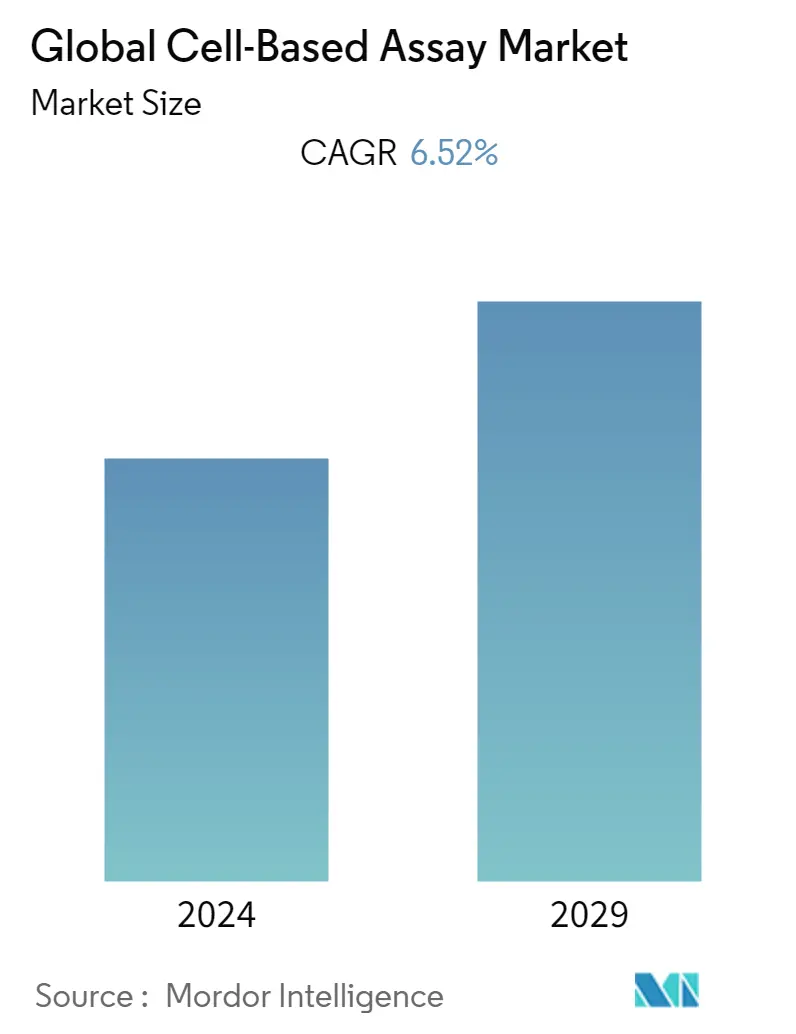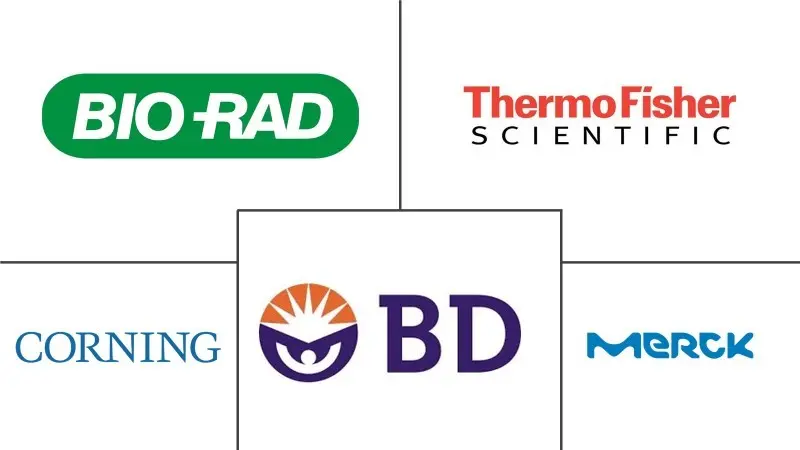Market Size of Global Cell-Based Assay Industry

| Study Period | 2019 - 2029 |
| Base Year For Estimation | 2023 |
| Forecast Data Period | 2024 - 2029 |
| CAGR | 6.52 % |
| Fastest Growing Market | Asia Pacific |
| Largest Market | North America |
Major Players
*Disclaimer: Major Players sorted in no particular order |
Cell Based Assay Market Analysis
The cell-based assay market is expected to register a CAGR of 6.52% over the forecast period.
COVID-19 had a significant impact on the growth of the market. the cell-based assays are useful to discover inhibitors of the COVID-19 virus infection. According to the article titled "A cell-based assay to discover inhibitors of SARS-CoV-2 RNA dependant RNA polymerase" published in June 2021 cell-based assay is used to evaluate the efficacy of nucleotide analog compounds against SARS-CoV-2 RdRp and the assay is used to assess their tolerance to viral exoribonuclease-mediated proofreading. Thus COVID-19 propelled the demand for cell-based assays during the pandemic period.
The cell-based assay market is expected to show rapid growth due to the rising prevalence of chronic diseases and lifestyle disorders, increasing investments in R&D for drug discovery, and the rise in technological advancements in cell-based methodologies.
The rising prevalence of chronic diseases and lifestyle disorders, such as cancer, cardiovascular, diabetes, and neurological disorders is one of the primary factors fueling the market growth. The report published by International Agency for Research on Cancer (IARC) in December 2020 that the global cancer burden has risen to 19.3 million cases. Additionally, according to estimates from the International Agency for Research on Cancer (IARC), by 2040, the global burden of cancers is expected to grow to 27.5 million new cancer cases. And thus, due to the high incidence of cancer around the world, the demand for effective therapy or treatment is increasing which is expected to drive the growth of the cell-based assay market during the forecast period.
According to the data published by the European Heart network in 2021 reported that in the European Union more than 60 million people live with cardiovascular disease and close to 13 million new cases of cardiovascular diseases are diagnosed every year. Thus, the rise in chronic diseases leads to demand growth for cell-based assays for new drug discoveries, making it a vital factor for market growth. In addition, the demand for cell-based assays has increased significantly owing to a surge in cell-based applications in drug discovery and the rise in technological advancements in cell-based assay methodologies.
Additionally, innovative product launches by key market players are expected to drive the growth of the market. For instance, in May 2021, Viskol launched DILI 3D cell culture assay services using corning-qualified 3D PHH spheroid assay-ready plates.
Thus the above-mentioned factors are expected to drive the growth of the market during the forecast period. However, high maintenance and operational costs are expected to hinder the growth of the market.
Cell Based Assay Industry Segmentation
As per the scope of the report, cell-based assays are versatile research lab tools used in healthcare. These tools are designed to target specific cells by using antibodies or other moieties, to determine the functionality and efficacy of drugs. Also, cell-based assays help to measure cell motility, and proliferation and facilitate research in the area of stem cells, immunology, cancer, and others. The cell-based assay market is segmented by Product (Cell Lines (Primary Cell Lines, Stem Cell Lines, and Others), Reagents and Kits, Microplates, and Other Consumables), Technology (Automated Handling, Flow Cytometry, label-Free Detection, High-throughput Screening, and Others), Application (Drug Discovery and Other Applications), End-user (Academic and Government Institutes, Pharmaceutical and Biotechnology Companies and Others) and Geography (North America, Europe, Asia-Pacific, Middle East and Africa, and South America). The market report also covers the estimated market sizes and trends for 17 different countries across major regions, globally. The report offers the value (in USD million) for the above segments.
| By Product | |||||
| |||||
| Reagents and Kits | |||||
| Microplates | |||||
| Other Consumables |
| By Technology | |
| Automated Handling | |
| Flow Cytometry | |
| Label-free Detection | |
| High-throughput Screening | |
| Others |
| By Application | |
| Drug Discovery | |
| Other Applications |
| By End-user | |
| Academic & Government Institutes | |
| Pharmaceutical and Biotechnology Companies | |
| Others |
| Geography | ||||||||
| ||||||||
| ||||||||
| ||||||||
| ||||||||
|
Global Cell-Based Assay Market Size Summary
The cell-based assay market is poised for significant growth, driven by the increasing prevalence of chronic diseases and lifestyle disorders, alongside advancements in technological methodologies. The market's expansion is further fueled by the rising demand for drug discovery, particularly in the wake of the COVID-19 pandemic, which highlighted the utility of cell-based assays in identifying inhibitors for viral infections. The growing incidence of conditions such as cancer, cardiovascular diseases, and diabetes has intensified the need for effective therapeutic solutions, thereby propelling the market forward. Additionally, the surge in research and development investments by biopharmaceutical companies is expected to bolster the market, as these assays play a crucial role in the discovery of new drugs. Innovative product launches and collaborations among key market players are also contributing to the market's dynamic growth trajectory.
Regionally, North America leads the cell-based assay market, supported by a robust healthcare infrastructure and a high adoption rate of these assays. The prevalence of chronic diseases in the United States, coupled with active market player engagements, underscores the region's dominance. The market is characterized by moderate fragmentation, with several global and regional companies, including prominent names like Becton, Dickinson and Company, and Thermo Fisher Scientific, Inc., driving competition and innovation. Despite the promising growth prospects, challenges such as high maintenance and operational costs may impede market expansion. Nonetheless, the ongoing advancements and strategic initiatives within the industry are expected to sustain the market's growth momentum over the forecast period.
Global Cell-Based Assay Market Size - Table of Contents
-
1. MARKET DYNAMICS
-
1.1 Market Overview
-
1.2 Market Drivers
-
1.2.1 Rising Prevalence of Chronic Diseases and Lifestyle Disorders
-
1.2.2 Increasing Investments in R&D for Drug Discovery
-
1.2.3 Rise in Technological Advancements in Cell-based Methodologies
-
-
1.3 Market Restraints
-
1.3.1 High Maintenance and Operational Costs
-
1.3.2 Lack of Skilled Personnel to Operate these Technologies
-
-
1.4 Porter's Five Force Analysis
-
1.4.1 Threat of New Entrants
-
1.4.2 Bargaining Power of Buyers/Consumers
-
1.4.3 Bargaining Power of Suppliers
-
1.4.4 Threat of Substitute Products
-
1.4.5 Intensity of Competitive Rivalry
-
-
-
2. MARKET SEGMENTATION (Market Size by Value - USD million)
-
2.1 By Product
-
2.1.1 Cell Lines
-
2.1.1.1 Primary Cell Lines
-
2.1.1.2 Stem Cell Lines
-
2.1.1.3 Others
-
-
2.1.2 Reagents and Kits
-
2.1.3 Microplates
-
2.1.4 Other Consumables
-
-
2.2 By Technology
-
2.2.1 Automated Handling
-
2.2.2 Flow Cytometry
-
2.2.3 Label-free Detection
-
2.2.4 High-throughput Screening
-
2.2.5 Others
-
-
2.3 By Application
-
2.3.1 Drug Discovery
-
2.3.2 Other Applications
-
-
2.4 By End-user
-
2.4.1 Academic & Government Institutes
-
2.4.2 Pharmaceutical and Biotechnology Companies
-
2.4.3 Others
-
-
2.5 Geography
-
2.5.1 North America
-
2.5.1.1 United States
-
2.5.1.2 Canada
-
2.5.1.3 Mexico
-
-
2.5.2 Europe
-
2.5.2.1 Germany
-
2.5.2.2 United Kingdom
-
2.5.2.3 France
-
2.5.2.4 Italy
-
2.5.2.5 Spain
-
2.5.2.6 Rest of Europe
-
-
2.5.3 Asia-Pacific
-
2.5.3.1 China
-
2.5.3.2 Japan
-
2.5.3.3 India
-
2.5.3.4 Australia
-
2.5.3.5 South Korea
-
2.5.3.6 Rest of Asia-Pacific
-
-
2.5.4 Middle East and Africa
-
2.5.4.1 GCC
-
2.5.4.2 South Africa
-
2.5.4.3 Rest of Middle East and Africa
-
-
2.5.5 South America
-
2.5.5.1 Brazil
-
2.5.5.2 Argentina
-
2.5.5.3 Rest of South America
-
-
-
Global Cell-Based Assay Market Size FAQs
What is the current Global Cell-Based Assay Market size?
The Global Cell-Based Assay Market is projected to register a CAGR of 6.52% during the forecast period (2024-2029)
Who are the key players in Global Cell-Based Assay Market?
Becton, Dickinson and Company, Bio-Rad Laboratories, Inc., Corning Inc., Merck KGaA and Thermo Fisher Scientific Inc. are the major companies operating in the Global Cell-Based Assay Market.

